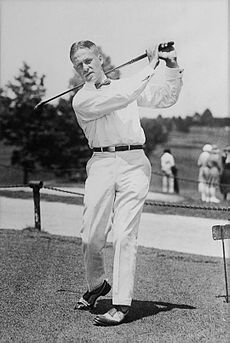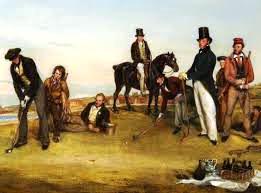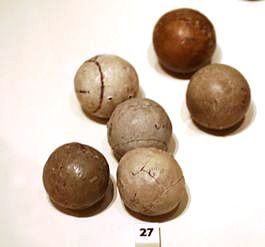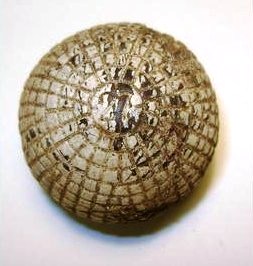There are three things in my life which I have no aptitude for. These are cooking, ironing and golf. Whilst I live with the first two to have no ability to play golf to any standard has always been sadness for me. I would have loved to have played off of a low handicap and have been a member of a pleasant golf club. But this was not to be!
However it has not stopped me exploring the world of golf and the collecting of memorabilia. And recently a visit to a beautiful golf club near Sandwich in Kent gave me the rare opportunity to witness a Fata Morgana. But more of that later!
As we all know the game of golf has been around since antiquity. The Romans played a version called paganica. An early game called jeu de mail popular in England many centuries ago has been seen as a forerunner to the modern game as it differed from the Roman game. A description of this ancient game can be found in the book entitled Historical Gossip about Golf and Golfers (1863) which you might be able to find although I cannot report that I have ever found one.

Portrait of John Taylor with his caddy.
Not so long ago I came across a painting by Sir John Gordon Watson of the famous amateur golfer John Taylor. I have a feeling that this was during a trip to Scotland but I cannot be sure. You quite often see paintings of various famous but now forgotten golfers in art galleries and very occasionally you will find either a coloured mezzotint or a painting for sale either at auction or in an arcade or shop. This said the only one I saw for sale was at an auction in Gloucestershire in the 1970s and the work fetched a respectable price even then. It is unlikely that you will find a known painting of the game or a famous son in an antique shop or the like. But what you will find are plenty of golf clubs and other golfing
memorabilia.
Hungerford has many examples for you to explore and enjoy. The earliest examples of golf clubs being manufactured date back to 1603. A William Mayne was appointed the Royal Club-Maker to King James the Sixth of Scotland and his Court. Sadly no examples remain although Will’s clubs are thought to have lasted well into the nineteenth century. But never say never as you do not know what is to be found.
The club itself in the early days was made of wood (normally pear or thorn) and this was due to the use of the feather ball. They were long and slender and pear shape in appearance and this style lasted until about 1850 and the advent of the much harder gutta-percha ball. After that they began to take on a more modern appearance. Today’s golf clubs although similar differ enormously from these very early clubs. If you are lucky you might find examples of these early clubs although I would think that as a rule you would be more likely to find later Victorian examples.
Golf balls are also fun to collect although the modern ones to me are a little androgynous. The original balls (c1400) were made from goose feathers which were enclosed in three pieces of bulls hide stitched together with twine. There was a boiling and pulping process and slowly the ball was hammered into shape. However as they were made of leather they had a tendency to fall apart especially if it rained. It was a laborious manufacturing process and because of this the balls were quite expensive.
Golf balls are so common and cheap these days that I believe that it would be more fun to collect golf balls with history attached to them. Maybe the golf ball might be mounted. A memory of a famous match or golfer. It might beinscribed. The list is endless.
I have seen various golf balls and clubs when doing the rounds and some even come with an illustration depicting the famous match.
You might find a ball connected with Tom Morris of St Andrews who apart from being a great player was also renowned for his ball making skills. Old Tom was also one of the first to embrace the innovative gutta-percha balls. Previous to Tom other famous golf ball makers were William Dickson of Leith (c1629) and George Law of St Andrews (c 1770). You will not find any of these very early balls as no examples are known to exist. But never say never as you do not know what is to be found.
Perhaps like me you have been waiting to find out what a Gutta-Percha golf ball was. In short it was a ball made from a type of India-rubber (Gutta-Percha) and if the story is to be believed was found by accident in the 1840s as packing materials around artefacts coming from the Asia. The material was soon recognised as being a very suitable material for making golf balls. The Gutta-Percha balls were much cheaper to produce than the feather balls (now considerably refined from their ancestors) although they could be a little erratic in flight. The Rubber-Core ball followed in the 1890s and so on and so on.
The nice thing about collecting golf balls is that they are so small that you could build up a memorable collection without having to move house. The same cannot be said for golf books which in my opinion outnumber all other golfing items by ten to one. No matter where you are, whether it be at a jumble sale or in a bookshop in the arcade or in a library, you will always find a book on golf.

Bobby Jones c. 1921
I own just one called Bobby Jones on Golf which dates from the 1920s. Usually a decent copy would have set me back about a tenner but as my copy had seen much better days it only cost me a pound. Bobby Jones (1902 -1971) was an American amateur golfer who was also a lawyer. He is credited in being the most successful amateur golfer to play at national and international level. At his peak (1923-1930) he dominated the amateur competitions and held his own against the top professionals such as Walter Hagen and Gene Sarazen. He also helped to design the Augusta National Golf Club and helped to found the famous Masters Tournament. The book is full of interesting topics such as Timing the Golf Stroke, Playing Short and Putting Psychology and is an interesting read. However Bobby with all his sound advice has not improved my golfat all. I still have ability of a newt. This is the only book I will own as I know that if I start to collect them then I will become addicted. Just think the dangers posed by titles such as The Golf Book of East Lothian or British Golf Links. One must never give in to this temptation.
If you are strong there are other items to collect from cigarette cards to prints from ceramics to flasks. You can collect medals from the lesser known tournaments or trophies from the past. Scorecards can be found quite easily as well as programmes and autographs (sometimes expensive) you will find tee pegs and advertisements and occasionally you find golf clothing dating back years. The list is endless. I do not collect at all but if you have a passion for the game then collecting ephemera can be fun and need not be expensive.
Earlier in this article I mentioned a visit to a golf club in Kent which enabled me to witness a mirage, a Fata Morgana. I was walking from Deal towards Sandwich Bay on what was the last really hot day of the summer. The beaches were crowded but as Sandwich Bay is so vast the area seemed almost empty. This was because to my left there was a large golf course which initially I thought to be the Royal St George’s Golf Club but it appears to have been the Princes Golf Club. As I made my way along the beach path the beautiful course shone brightly in the high summer sun. A few golfers were out braving the heat. One of the holes was actually on the beach itself (to the right of the path facing Ramsgate). That day I walked as far as Pegwell Bay and then turned around and after swimming for a while (the sea was very warm) I took the beach path towards Deal and fish and chips. The sun was dipping a little by then and with the golf course now to my right (and empty) I was briskly walking towards my meal when I noticed what appeared to be an island off the coast of France. There no islands in this area of sea. It was a mirage. France can often be seen from this part of Kent but mirages are quite rare although not unknown. I sat down, with the golf course behind me, and looked out to sea as the mirage slowly faded (this took over an hour and a half). The sense of peace was overwhelming and when I looked at the course again it was bathed in deep green shadows. I may be wrong but although the course was naked of golfers the essence of the game was strongly there. The ghosts of the many generations of golfers who had enjoyed this course could be sensed although they could not seen as they were as transient as the mirage I was witnessing. It has taken me many years to understand the game I cannot play well. But I think I understand it now!
I will pick up odd items of golfing memorabilia as they interest me but that is all as I do not want to fill my cottage. But do not let this put you off. There is plenty of golfing memorabilia out there ready to collect. Happy Hunting.


